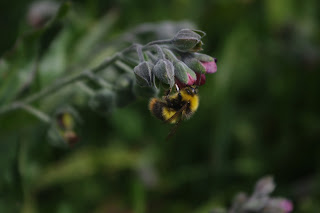Here are some more wildflowers I spotted during my walk via Knocking Hoe, the Pegsdon Hills and the Barton Hills on Saturday. As I noted there were some little beauties nestling low among the grasses but I saw a number of taller species too. I don't think any of these have featured in the diary before. There were a good many Hound's-Tongue (Cynoglossum officinale) much favoured by bumblebees.
Just beyond the Pegsdon Hills where I joined the Icknield Way there is a pocket of woodland. Stopping for a moment in the semi-gloom I noticed a profusion of White Helleborine (Cephalanthera damasonium).
Always a delight to encounter Orchids. I assumed they were yet to come into full flower but I gather that the flowers rarely open. They do attract insects but it is thought they are largely self-pollinating.
Something of a rarity -largely restricted to southern England on this isle- but can be found as far north as Sweden and as far east as Asia.
About half way between the Pegsdon and Barton hills the Icknield Way becomes a tarmac lane rather than a track. Some say it is the oldest route in England still in continuous use. In stretches it has become sections of both minor and major roads yet in parts is no more than a footpath.
At this point a crossroads is formed with the road that connects the villages of Lilley and Hexton. The verges here are fabulous for wildflowers. I assume they represent a survival from the surrounding fields which are now intensively farmed arable monocultures.
I saw something yellow glinting in a ditch which proved to be Yellow Loosestrife (Lysimachia vulgaris). I have not seen this moisture-loving species anywhere else in the area which is one of the drier parts of the country. Perhaps this patch is the one and only?
John Shipton of Shipton Bulbs once published a blog called "A guide to five star ditches". Accordingly I award this ditch five stars.
On Barton Hills I came across this lovely display. Which begs the question: what is it? I think it might be Greater Burnet-Saxifrage (Pimpinella Major).
Anyway all in all a good walk for wildflowers. I'll aim to repeat it in month or so when the flowers of high summer should be reaching their peak.







